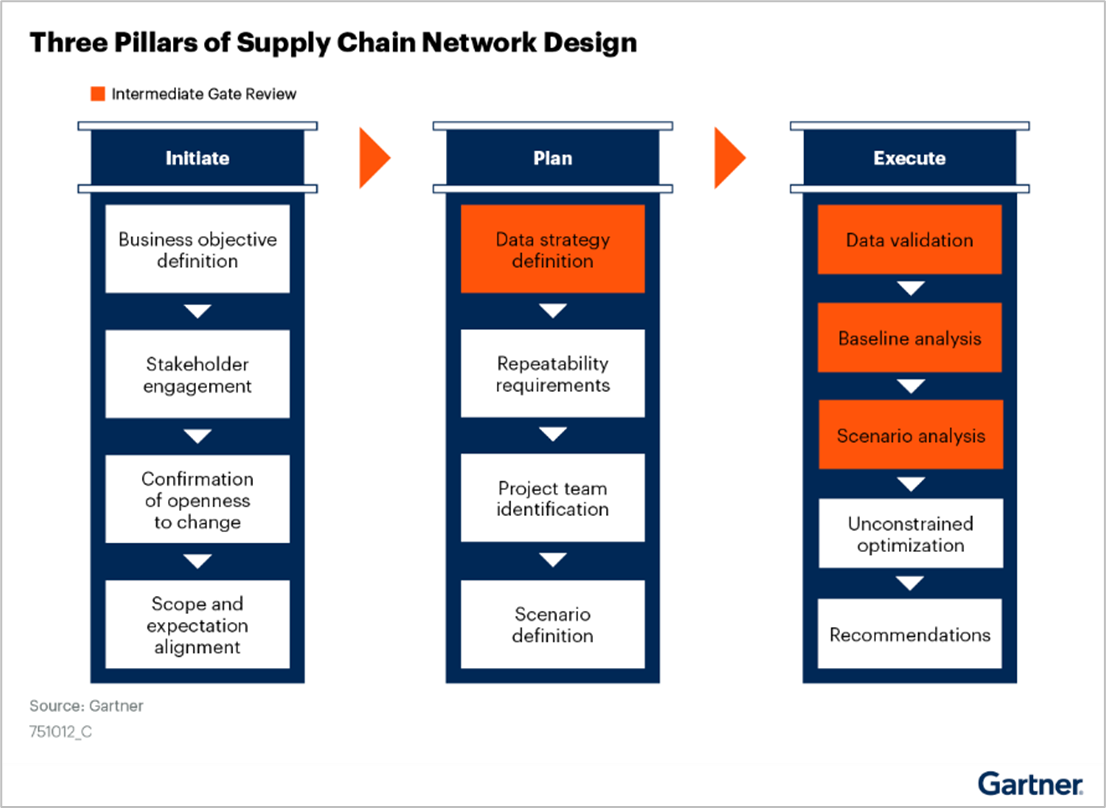Network design implementations are also notorious for spinning their wheels when scenario modeling and analysis bog down people and other resources to a point where initiatives fail, experience cost and schedule overruns, or simply underperform. So what can leaders do to support successful supply chain network design initiatives?
Start with the Right Objectives
Gartner looks at supply chain network design across three pillars – Initiate, Plan, and Execute (see figure below). The very first step in the Initiate phase is Business Objective Definition. Getting initiatives off on the right foot with properly defined and broadly considered objectives is critical. Initiatives that start one way and then try to extend scopes midstream end up blurring focuses and slowing down the process. Others that get laser-focused on one objective (e.g., distribution center footprint reduction) without proper consideration for how potential actions will affect other areas (e.g., customer service levels) can implement perceived solutions that instead create bigger problems.

As noted above, objectives for supply chain network optimization now have to go beyond the narrow lens of faster and cheaper. With pandemic, geopolitical, environmental, and a range of unpredictable impacts now in play, resilience and business continuity planning is more important than ever. Establishing the right objectives and goals needs to be tied to the broader needs of the business and customers and aligned upon by the right stakeholders and SMEs who should all be involved intelligently throughout the lifecycle of the project.
Solidify Scenario Modeling and Evaluation
Scenarios for potential actions and impacts come into play in the Plan and Execute phases of supply chain network design. Project leaders have historically approached scenario modeling and evaluation with a range of tools and methods with varying degrees of success and limitation. Key questions include – Can the required range of needed scenarios be run at the same time? How long (and how many people) will it take to spin up the scenarios? How difficult will it be to modify scenarios moving forward? Sacrifices in these areas lead to sacrifices in the success of the network design initiative.
Still prevalent for many is a well-intended but ineffective array of Excel spreadsheets that can’t handle the complexities of network design and concurrent analysis of multiple constraints. They force a slow and sequential process that ultimately doesn’t provide actionable insights. Others have opted for narrowly focused tools that, on the surface, seem a fit for their objective (e.g., manufacturing tools that focus on throughput, transportation tools that focus on mileage and routes). But while these tools may be beneficial in one area, they don’t provide a holistic view of how others will be impacted by the proposed solutions they influence.
Understandably, one would think that focused Network Design solutions would be the way to go. The issue with these supply-chain-centric tools is similar to the transportation or manufacturing tools noted above in that they’re unable to examine strategy and policy decision tradeoffs across the full value chain. Fortunately, organizations can now adopt a single solution that lets them integrate a full range of financial and operational modeling that considers the end-to-end value chain and gives them incredibly powerful scenario modeling and analysis capabilities.

Apply the Power of a Digital Twin
A Digital Twin is a complete virtual mirror of the full value chain that uses real-time or near real-time data from multiple sources and reflects all key relationships and functions. Having a digital twin enables organizations to examine a limitless array of variables impacting supply chain network design – all in a safe and secure environment before real actions are taken.
Better yet, a Digital Twin that incorporates a Prescriptive Analytics Platform goes beyond “what will happen” to answer the bigger question of “what should I do?” A Digital Twin gives leaders the ability to wade through every factor, weed out infeasible outcomes, examine tradeoffs, quantify risks associated with different decisions, and find the path that best meets the set of objectives at hand.
In short, a Digital Twin supports successful supply chain network design initiatives and leads to better financial and operational performance. This is especially the case when deployment occurs in environments that were previously supported primarily via the traditionally-used tools noted in the previous section.
Simplifying Complexity for Competitive Advantage
To echo our initial point, supply chain network design is becoming increasingly important given the unprecedented and often unpredictable variables that businesses are contending with today to get their products to market and serve their customers. As leaders embark on supply chain network design initiatives in the months ahead, they must begin with the right objectives, adopt an approach that supports next-level scenario modeling and evaluation, and leverage technologies like Digital Twins to improve performance and minimize risk.
—
To learn more about strengthening your supply chain network design efforts with River Logic, get in touch with us today.



